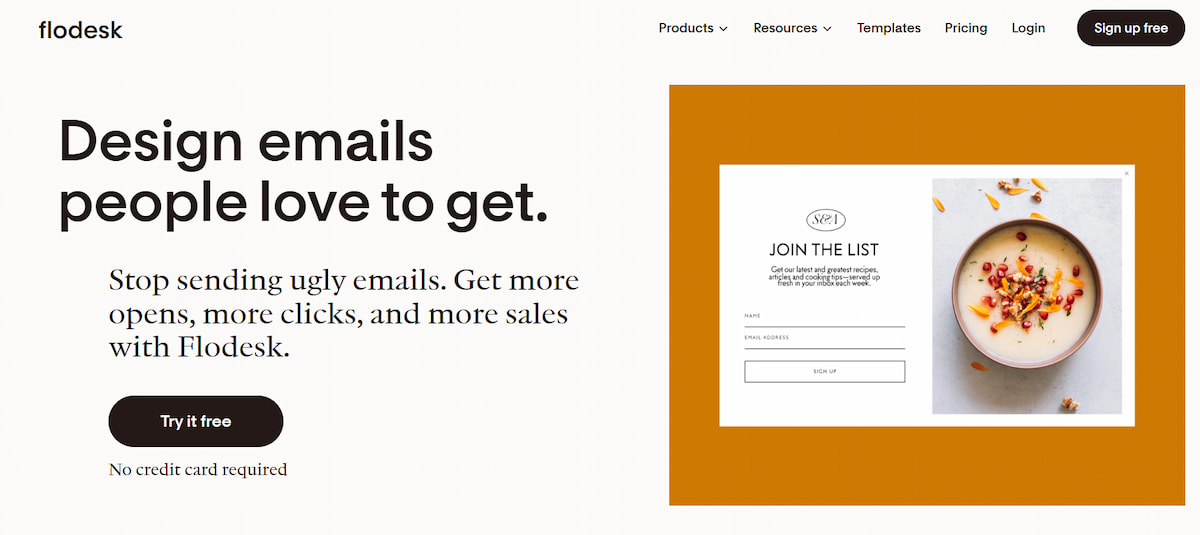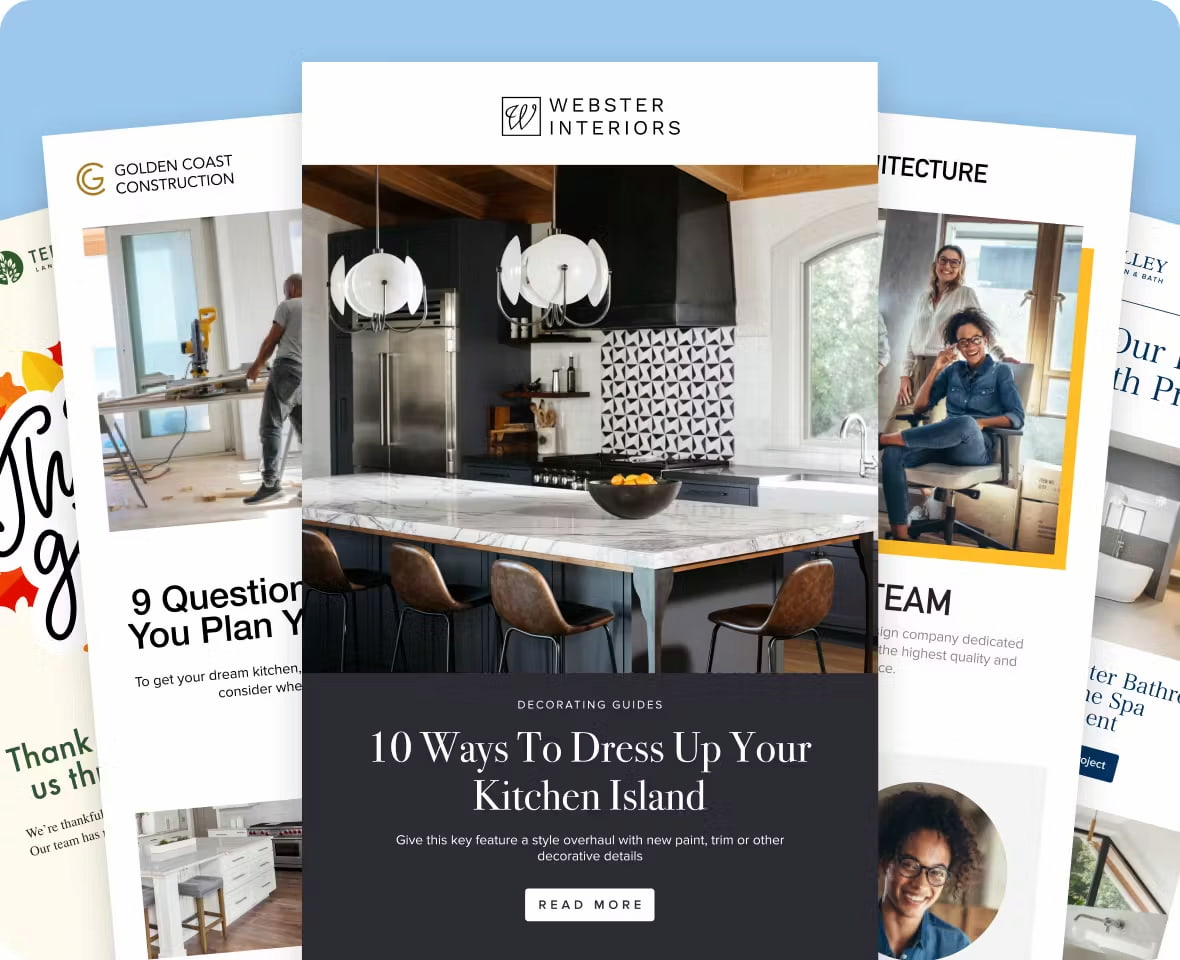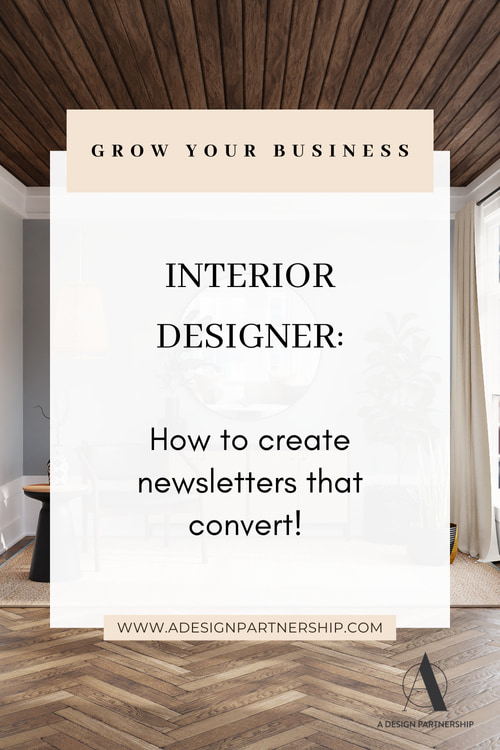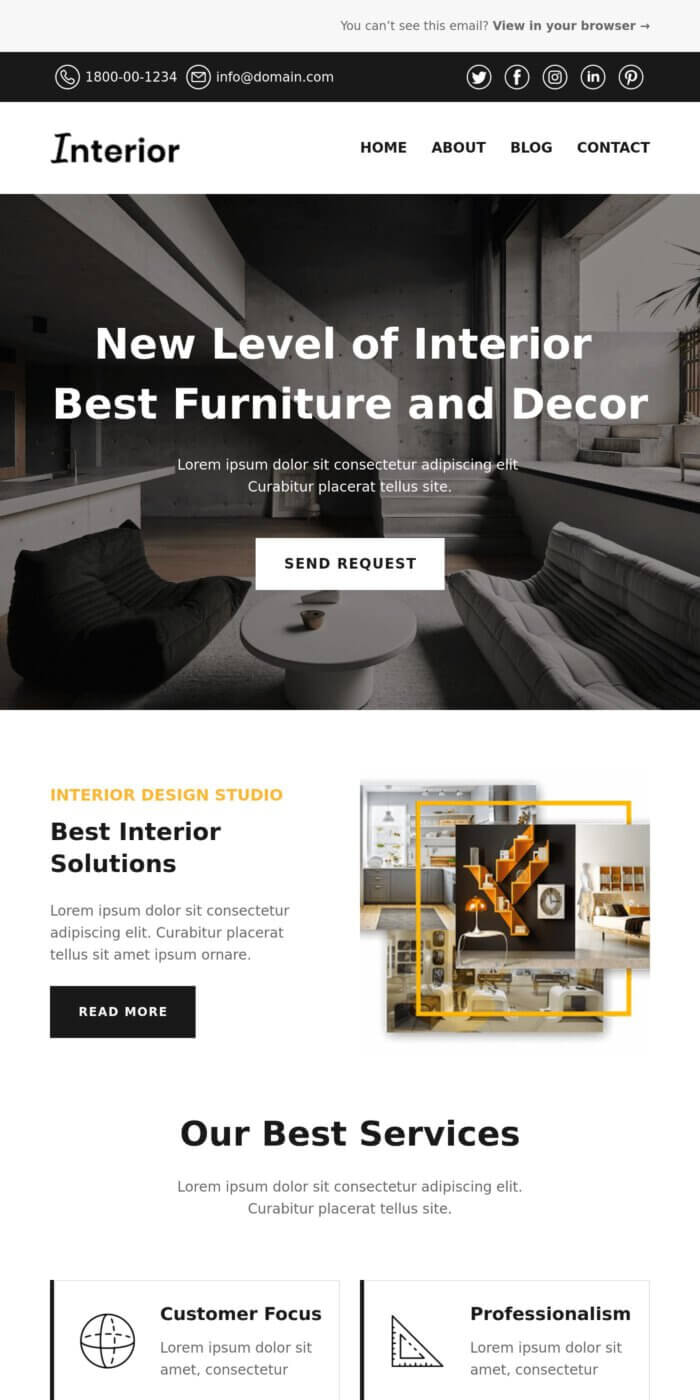In the interior design industry, effective marketing is a necessary component for business growth. Social media provides visibility but offers limited control, as audiences are subject to platform algorithms and trends.
Interior design services require trust and significant financial investment from clients, making a reliable and direct communication channel essential. Email marketing for interior designers meets this need and is a core part of a modern design firm’s strategy rather than an optional addition.
Email marketing functions as a primary channel for lead generation, client retention, and sales conversion.
This article explains the practical reasons for using email marketing and outlines the specific strategies that are effective for interior designers in 2025.
Table of Contents
The Importance of Email Marketing for Interior Designers
An interior design business is built on strong client relationships and a well-presented portfolio. While social media increases visibility, it does not provide consistent or reliable engagement.
Email marketing offers a controlled and direct channel to maintain client connections, demonstrate expertise, and generate new business. It is an effective tool for converting interest into long-term trust and securing repeat projects.
You Own Your List, You Control the Connection
Here’s the biggest thing to understand: your Instagram followers aren’t really yours. You’re basically borrowing them from Meta, and they can decide to show your posts to fewer people anytime they want.
Your email list, though? That’s your asset. It’s a list of people who have literally given you permission to talk to them.
That’s a much stronger connection than a follow. It’s your safety net, so you’re never solely dependent on a social media platform to reach your audience.
It’s How You Build Real Trust
Your clients aren’t just hiring a service; they’re letting you into their home and their life. That’s a big deal, and it runs on genuine trust. You can’t get that with pushy sales emails.
Trust comes from giving real value. Share a useful design tip. Show them how your process works. Give them a solution to a problem they have.
When you share what you know without immediately asking for a sale, you stop being just another designer. You become the trusted expert they’ll call when they’re ready to start.
It Directly Gets You Clients and Sales
Someone on your email list is already interested in what you do. They’ve raised their hand. That makes them way more likely to hire you than a random social media scroller. An email showing a beautiful finished kitchen can prompt a past client to rehire you for their living room. An announcement that you’re opening up two new client spots for the fall creates urgency.
The numbers don’t lie – email consistently delivers a massive return on investment because you’re talking to people who already want to listen.
You Can Tailor Your Messages (Without More Work)
Tools like Flodesk and Mailchimp are great because they let you get specific. You can group your subscribers. Send your commercial project updates to business owners and your residential design tips to homeowners. Share modern minimalist inspiration with those who love that look and cozy traditional ideas with others.
This means people get content that actually matters to them, which makes them much more likely to open your emails and engage.
You can also check out 6 Email Marketing Engagement Strategies you (Probably) Haven’t Tried to explore additional ways to boost interaction and keep your audience interested.
Your Work Looks Its Best
Social media often reduces image quality, but email does not. In design, details matter – the weave of a fabric or the finish on a hardware pull. Email allows high-resolution photos that present the work accurately and with impact.
You can even embed short video tours or link to a blog post with more pictures. It’s the best way to give people a true feel for your design style and the quality of your projects.
5 The Best Practices for Email Marketing for Interior Designers
The basic principles of email marketing remain consistent, but the methods that bring the best results continue to change. Here are the current practices that help email marketing for interior designers perform effectively.
List Building: Growing Your Curated Community
The foundation of any successful email strategy is a growing, engaged list. Move beyond the simple “Subscribe to our newsletter” footer on your website.
Lead Magnets with High Perceived Value
Generic PDFs are no longer effective for generating leads. To get an email address, you need to offer something truly valuable that feels like a fair trade.
Your audience will only sign up if they believe the content will solve a specific problem for them. The goal is to offer a practical tool or resource, not just information.
Here’s what that looks like:
- A Mini-Course: Get a daily email for a week with your “5 Days to Define Your Design Style” challenge. It feels personal and super valuable;
- A Secret Swipe File: Who doesn’t want the inside scoop? Offer your “Top 50 Paint Colors for North-Facing Rooms.” This is gold for anyone who’s struggled with a dark, tricky space;
- The Ultimate Checklist: Not just a guide, but “The Ultimate Checklist for Planning Your Kitchen Renovation.” It’s the kind of thing people print out and take to the store;
- A Quick Workshop: A short video called “How to Style Your Bookshelves Like a Pro.” It’s immediate, engaging, and feels like a real peek behind the curtain.
Strategic Website Placement
Use pop-ups (exit-intent pop-ups are highly effective), embedded forms within relevant blog posts (e.g., a post on “Choosing the Perfect Sofa” has a form for your “Furniture Buying Guide”), and a prominent button on your homepage.
Use Face-to-Face Time to Grow Your List
Don’t let a good conversation end when the event does. Come prepared to every meeting, open house, or networking event with a simple way for people to join your list. Keep a sign-up sheet handy or use a QR code that takes them straight to your sign-up page. It’s the easiest way to keep the connection going.
Segmentation: The Heart of Modern Email Marketing
Blasting every email to your entire list is a strategy of the past. Market segmentation is the key to relevance, and relevance is the key to engagement.
Basic Segments to Create
- Leads vs. Clients: The messaging for someone who has never worked with you is different from someone who has;
- Project Type: Residential, Commercial, Hospitality;
- Style Preferences: Tag subscribers based on which lead magnet they downloaded or which project gallery they clicked on;
- Engagement Level: Create a segment of “VIP Subscribers” who open every email. Reward them.
The Post-Project Segmentation
After a project is complete, add clients to a special segment. This allows you to send them maintenance tips, offers for seasonal styling, or requests for referrals without bothering your broader audience.
Content Strategy: Providing Value Beyond Promotion
Your goal is to have people look forward to your emails, not delete them. A good rule of thumb is to make 90% of your content genuinely useful, and only 10% about promoting your services.
The Signature Newsletter
This should be your regular touchpoint (bi-weekly or monthly is often ideal for designers). Structure it with:
- A Featured Project: Go beyond the final photo. Pick a recent job and share a short story. Explain why a specific light fixture was the perfect choice or how you worked around an awkward room layout;
- Industry Insights: Share your thoughts on 2025’s color of the year, emerging sustainable materials, or a trend you love (or one you think is on its way out);
- A Curated Tip: “How to Mix Metals,” “The Rule of Three for Accessories,” “Choosing the Right Rug Size”;
- Product Highlight: Showcase a new furnishing line, a unique artisan you partner with, or a favorite sourcing find;
- Personal Touch: Briefly share a peek behind the curtain – a photo from a sourcing trip, a book you’re reading that inspires you. This builds personal connection.
Automated Email Sequences (The Gold Standard)
Automated sequences provide structure and efficiency in client communication. A welcome series introduces new subscribers and highlights the firm’s value. A nurture sequence, triggered after an inquiry without a booking, addresses concerns and encourages a decision. Post-project sequences include a thank-you message, feedback or review requests, and a follow-up sent later to maintain the relationship and support referrals.
Design and Aesthetics: Your Visual Handshake
As a designer, your emails should represent your sense of style. A badly designed email might damage your credibility. Treat each communication as an extension of your brand.
Mobile Comes First
Most people will open your email on their phone, so it needs to look great on a small screen. Stick to a simple, single-column layout, use fonts that are easy to read, and make sure buttons are large enough to tap easily.
Stay True to Your Brand
Be consistent with your logo, color scheme, and fonts. This helps people recognize your work immediately.
Use Great Images
Always include high-quality, professional photos. Display both big photos that convey the atmosphere of a space and close-ups that highlight details.
Keep It Clean and Easy to Read
Use clear headings, short paragraphs, and plenty of space. People skim emails, so make yours easy to digest.
Try Adding Video
Short videos, such as a brief room tour, a design idea from you, or a time-lapse of your approach, may significantly increase email engagement.
Analytics and Optimization: The Path to Growth
Monitoring performance is essential in email marketing. Platforms collect data to assist in identifying strengths and areas for development.
- Open Rate: % of opened emails (~20% average). Improve with clear, relevant subject lines and timing;
- CTR: % of link clicks (~3% average). Strengthen with engaging content, CTAs, and effective design;
- Conversion Rate: % completing key actions. Raise with relevant offers and optimized, mobile-friendly pages;
- Unsubscribe Rate: Normal at low levels; spikes show issues with targeting, content, or frequency;
- A/B Testing: Compare small changes to identify what works best and refine campaigns.
Email Marketing for Interior Designers Advanced Strategies
If you want to get ahead this year, you need to do more than the basics. Here are the key tactics that will actually make a difference.
Interactive Content
Stop making your emails a one-way conversation. Add elements that get people to interact with you. Use simple polls to let them vote on options (“Which fabric for this headboard: A or B?”). Create image hotspots where they can hover over a picture to see product details. Or, add a short quiz like “Find Your Perfect Design Style.”
This makes your content more engaging and less easy to ignore.
Hyper-Personalization with AI
Personalization now means more than just using someone’s first name. Use AI tools to look at what each subscriber actually does – what they click on and what they buy. Then, use that data to automatically fill your emails with the products or articles they are most likely to care about.
This makes your messages feel specifically tailored to them, which greatly increases engagement.
Integration with Other Systems
Your email platform should be compatible with your other applications, like as CRM and project management systems. When these systems communicate data automatically, your marketing becomes considerably more effective and accurate.
For example, you may create a rule that would automatically send a “refresh” offer to clients exactly two years after their project is done. This degree of targeting is both efficient and very effective.
Design for Everyone
Make sure your emails are easy to read for all your subscribers. Always add descriptive alt text to images. Choose colors with enough contrast between the background and the text. And write clear, meaningful links – like “See our latest upholstery collection” – so everyone knows where they’re going. It’s good for people, and good for your business.
Conclusion
Success in interior design is determined not only by inventiveness but also by the maintenance of solid relationships with clients. Email marketing for interior designers is a practical approach to managing these connections at scale, providing a direct route with personalized content that other platforms cannot match.
It helps turn initial inquiries into paying clients, supports repeat projects, and drives steady business growth. Designers who succeed today are those who view their email list as a core business asset. A list is more than a set of addresses – it represents clients and potential clients who have chosen to stay connected. Managing it carefully ensures consistent trust, stronger engagement, and long-term opportunities.



